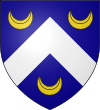Clan Durie
| Clan Durie | |
|---|---|
 Crest: A crescent Or | |
| Motto | CONFIDO (I trust) |
| Profile | |
| Region | Lowlands |
| District | Fife |
| Chief | |
 | |
| Andrew Durie of Durie[1] | |
| Chief of the Name and Arms of Durie | |
| Historic seat | Burntisland Castle |
Clan Durie is a Lowland Scottish Clan.[2]
History
Origins of the clan
The origin of the surname is uncertain but it is thought to derive from the French Du Roi.[2] This could indicate that the Duries arrived in Britain with the Normans.[2] Other research suggests that the Duries travelled to Scotland in 1069 as part of the entourage of Queen Margaret of Scotland.[2] The Duries settled in Fife and there are records of them in that ancient kingdom from as early as 1119.[2] However it is generally accepted that the Duries rose to prominence as administrators to Princess Joan, who was the daughter of Henry III of England and wife of Alexander II of Scotland.[2]
The Duries were granted the estate of Craigluscar which is near Leven, Fife.[2] A house that was built here in 1520 has a stone bearing the initials of George Durie and his wife Margaret Bruce.[2] The family's prominence in Fife is found in charters throughout the thirteenth and fourteenth centuries.[2] In about 1258 Duncan de Dury was a witness for Malise, Earl of Strathern.[2] Others bearing the name who appear in documentary evidence include Francis de Douery (c.1250), Malisius de Douery (c.1350), Michael de Douery (c.1373), John de Douery (c.1406) and Richard de Douer (c.1405).[2] It is from Richard de Douer that the main chiefly line is descended from.[2]
In 1382 Burntisland Castle (now known as Rossend Castle) was built and it includes a tablet over the entrance bearing the Durie arms and the date 1554.[2]
16th and 17th centuries
Burntisland Castle was the most extensive of Durie properties and in 1563 it was occupied by Mary, Queen of Scots.[2] However it was confiscated by the Crown during the Scottish Reformation.[2]
George Durie reached high offices in church and state, becoming Commendator and the last Abbot of Dunfermline before the Reformation.[2] He also appeared in Parliament between 1540 and 1554, was appointed an Extraordinary Lord in 1541, became Lord of the Articles, a member of the Governor's Secret Counsale in 1543, a Lord of Council and Session and Keeper of the Privy Seal of Scotland.[2] George Durie was a staunch supporter of Mary, Queen of Scots and as a bitter opponent of the new faith he brought his own cousin, John Durie, a monk to trial for proclaiming the new teaching.[2] The Queen and her mother, the Queen-Dowager wrote several letters to George Durie while in distress and sent him on diplomatic missions to the court of France.[2] Durie later fled there taking with him the relics of Queen Margaret for safe keeping.[2]
George Durie's brother was Andrew Durie who was Abbot of Melrose and Bishop of Galloway.[2] Andrew Durie was despised by the religious reformer John Knox and was imprisoned in Edinburgh Castle in 1580.[2] Meanwhile, Robert Durie, minister of Anstruther, was exiled for attending a proscribed General Assembly of the Church.[2]
George Durie's sons, John and George, were both educated at the Scots' Colleges in Paris.[2] There is little doubt that John was the Jesuit Durie who was implicated in a conspiracy to release Mary, Queen of Scots and depose Elizabeth I of England.[2] Another of George's sons was Henry Durie who held the lands of Craigluscar and from whom the main line of the family runs.[2] His wife was Margaret MacBeth who was renowned for her skill with herbs.[2] Margaret was attended royal births at Dunfermline Palace and was a favourite of Anne of Denmark.[2]
In the late 17th century another George Durie was a Captain in King Louis XIV of France's Scots Guards and also a provost of Dunfermline.[2]
Chief of the Name and Arms of Durie
The Duries were chiefless for some time until the recognition of Lt-Col Raymond Durie of Durie in 1988.[2] He established his descent through his grandmother, Elizabeth Durie of Craigluscar from Abbot George.[2] Raymond had a distinguished military career which spanned 35 years with Argyll and Sutherland Highlanders. His actions were distinguished during the Chinese Civil War and Japan's invasion of China.[2] He died in 1999 and the chieftainship passed to his son, the present chief Andrew Durie of Durie, CBE[3]
Lands and castles
The main seat of the family of Durie of that Ilk was Durie in the parish of Scoonie, Leven, Fife. Another branch, that of the present Chief, had Craigluscar, near Dunfermline, Fife. Briefly, they held Rossend Castle (Burntisland, Fife) [4] and Grange (near Kinghorn, Fife).
See also
External links
References
- ↑ Clan Durie Profile scotclans.com. Retrieved 15 September 2013.
- 1 2 3 4 5 6 7 8 9 10 11 12 13 14 15 16 17 18 19 20 21 22 23 24 25 26 27 28 29 30 31 32 Way, George and Squire, Romily. Collins Scottish Clan & Family Encyclopedia. (Foreword by The Rt Hon. The Earl of Elgin KT, Convenor, The Standing Council of Scottish Chiefs). Published in 1994. Pages 126 - 127.
- ↑ Standing Council of Scottish Chiefs - select "Durie" from the drop down list clanchiefs.org. Retrieved 15 September 2013.
- ↑ brand-dd.com